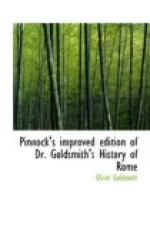12. The most celebrated and conspicuous buildings were in the eighth division of the city, which contained the Capitol and its temples, the Senate House, and the Forum. The Capitoline-hill was anciently called Saturnius, from the ancient city of Satur’nia, of which it was the citadel; it was afterwards called the Tarpeian mount, and finally received the name of Capitoline from a human head[11] being found on its summit when the foundations of the temple of Jupiter were laid. It had two summits; that on the south retained the name Tarpeian;[12] the northern was properly the Capitol. 13. On this part of the hill Romulus first established his asylum, in a sacred grove, dedicated to some unknown divinity; and erected a fort or citadel[13] on the Tarpeian summit. The celebrated temple of Jupiter Capitoli’nus, erected on this hill, was begun by the elder Tarquin, and finished by Tarquin the Proud. It was burned down in the civil wars between Ma’rius and Syl’la, but restored by the latter, who adorned it with pillars taken from the temple of Jupiter at Olympia. It was rebuilt after similar accidents by Vespa’sian and Domitian, and on each occasion with additional splendour. The rich ornaments and gifts presented to this temple by different princes and generals amounted to a scarcely credible sum. The gold and jewels given by Augustus alone are said to have exceeded in value four thousand pounds sterling. A nail was annually driven into the wall of the temple to mark the course of time; besides this chronological record, it contained the Sibylline books, and other oracles supposed to be pregnant with the fate of the city. There were several other temples on this hill, of which the most remarkable was that of Jupiter Feretrius, erected by Romulus, where the spolia opima were deposited.
14. The Forum, or place of public assembly, was situated between the Palatine and Capitoline hills. It was surrounded with temples, basilicks,[14] and public offices, and adorned with innumerable statues.[15] On one side of this space were the elevated seats from which the Roman magistrates and orators addressed the people; they were called Rostra, because they were ornamented with the beaks of some galleys taken from the city of Antium. In the centre of the forum was a place called the Curtian Lake, either from a Sabine general called Curtius, said to have been smothered in the marsh which was once there; or from[16] the Roman knight who plunged into a gulf that opened suddenly on the spot. The celebrated temple of Ja’nus, built entirely of bronze, stood in the Forum; it is supposed to have been erected by Numa. The gates of this temple were opened in time of war, and shut during peace. So continuous we’re the wars of the Romans, that the gates were only closed three times during the space of eight centuries. In the vicinity stood the temple of Concord, where the senate frequently assembled, and the temple of Vesta, where the palla’dium was said to be deposited.




